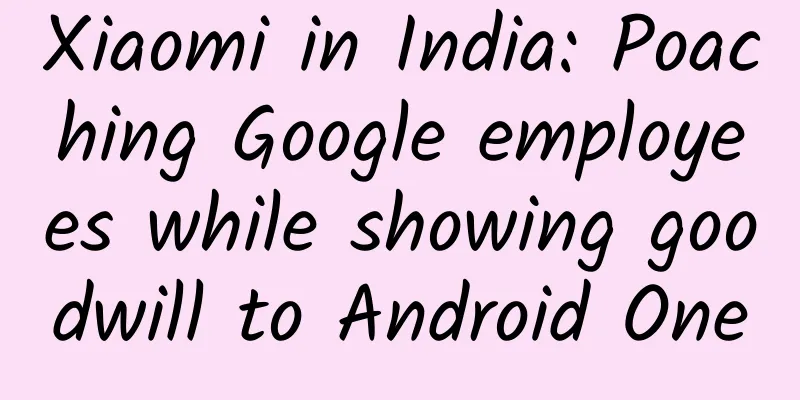Xiaomi in India: Poaching Google employees while showing goodwill to Android One

|
After Google teamed up with three major Indian local manufacturers, Micromax, Karboon and Spice, to launch Android One models, Redmi and Android One, which are in the same price range, are in direct competition in the Indian market. Xiaomi's attitude towards Android One has always been unclear. Yesterday, Hugo Barra, one of the heads of Xiaomi's international business, accepted an interview with Indian media and expressed goodwill to Google. "We also want to do Android One in the future, it's just a matter of time. But now we will not open a new product line, but focus on existing products." Barra also revealed that Android One is a project that Google has been brewing for a long time. He was involved in the pro-China movement when he was Google VP before he jumped to Xiaomi. Barra commented that Android One is a clever step taken by Google. However, the reporter who interviewed Hugo Barro revealed on his Twitter that Barro complained that the Android One model was "overpriced" in the interview. The price of Redmi in India is 5999 Indian rupees (about 600 RMB), while the Android One is 6399 Indian rupees. Interestingly, the reporter did not include this in the report. Hugo Barra said this just to convey goodwill, Xiaomi does not have a timetable or clear plan for Android One. Moreover, Xiaomi's existing product line is not compatible with Android One. All of Xiaomi's current products use off-screen buttons (menu, home, and return buttons), while native Android has long abandoned physical buttons and instead uses virtual buttons on the screen, which means that existing Xiaomi models cannot be directly adapted to native Android. Google tightly controls the software and hardware experience of Android One and only provides a limited set of hardware solutions. If Xiaomi launches Android One, it must abandon MIUI and choose native Android, and it must also design new models under Google's hardware guidance. Currently, Xiaomi's main selling model in the Indian market is Redmi, and Xiaomi is stepping up its pace of distribution in the Indian market. Barra revealed that Redmi Note will be launched in the Indian market at the end of December, and Mi 4 with MIUI 6 will also be launched at the end of this year or early next year. Xiaomi TV and Xiaomi bracelet are also expected to be launched in India next year. Hugo Barra revealed on Google+ today that Xiaomi has also hired Jai Mani, a former Google employee, as Xiaomi India's top product manager. Before leaving the company to start his own business at the end of 2013, Jai Mani was in charge of Google Play-related business and was also a familiar face at Nexus and Android conferences:
Jai Mani's work should focus on the localization of MIUI, especially optimizing Xiaomi's software and services for the Indian market. Judging from the poaching, Xiaomi will further strengthen the software and hardware integration of its own products in the Indian market. In addition to the friendly signals, the competition between Xiaomi India and Android One will continue to intensify. |
<<: Android: An efficient UI is a cool UI (Part 1)
>>: The truth about the 12 programmers
Recommend
How does the wedding photography industry use TikTok? Case Study
"For wedding photos that only happen once in...
How to place massive Qianchuan search ads?
Qianchuan has fully opened up the delivery of sea...
How much does it cost to make a shoe and boots mini program in Yueyang?
How much is the quotation for shoe and boot manuf...
Liu Yudong: Controlling TV games with a mobile phone sounds great
TV games have a very broad category. They include...
When will Alipay collect blessings in 2020? Mutual assistance and strategies for collecting blessings cards in 2020!
In recent years, in addition to the traditional w...
Google Android 12 Beta 5 released: many details have been changed, and the official version is coming soon
September 9 news Google released the Android 12 B...
Why do we need to analyze user behavior?
1. What is user behavior ? User behavior is compo...
China Automobile Dealers Association: Analysis of the Pickup Truck Market in July 2023
According to the data from the China Passenger Ca...
Tractica: AI software global revenue will reach $126 billion in 2025
Artificial intelligence (AI) across consumer, ent...
Typhoon Tali has just landed in Zhanjiang, Guangdong! It may land again, please take precautions!
According to the Central Meteorological Observato...
Coughing and leaking urine, loose belly, back pain... all of these are related to this muscle! 1 simple movement to test yourself
Rectus Abdominis Separation This is not unfamilia...
iPhone XS signal is worse than previous generation? We tested it to see if it works.
[[244806]] With the iPhone XS series going on sal...
Baidu wants to disable pop-up dialog windows for mobile promotion. What do you think?
(1). Then don’t use pop-ups. Consider the user ex...
Wuwei College Teacher Li Dong's five-day training camp for bull stock trading
Introduction to the bull stock trading resources ...









